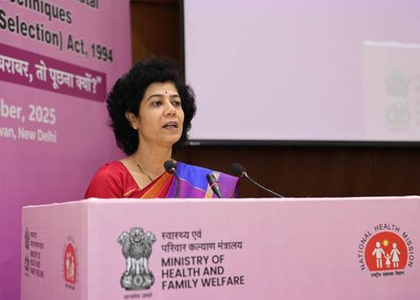India’s sex ratio at birth improved with 917 females per 1,000 males in 2021-23: Centre
By IANS | Updated: October 6, 2025 17:55 IST2025-10-06T17:54:44+5:302025-10-06T17:55:16+5:30
New Delhi, Oct 6 Strengthening the Pre-Conception and Pre-Natal Diagnostic Techniques (Prohibition of Sex Selection) Act has led ...

India’s sex ratio at birth improved with 917 females per 1,000 males in 2021-23: Centre
New Delhi, Oct 6 Strengthening the Pre-Conception and Pre-Natal Diagnostic Techniques (Prohibition of Sex Selection) Act has led to an improvement in the Sex Ratio at Birth (SRB), with 917 females per 1,000 males recorded in 2021-23, said Aradhana Patnaik, Additional Secretary & Mission Director (NHM), Ministry of Health and Family Welfare, on Monday.
Speaking at a National Sensitisation Meeting on Strengthening the Pre-Conception and Pre-Natal Diagnostic Techniques (Prohibition of Sex Selection) Act, 1994, here she highlighted the progress made in the SRB over the last decade.
“The country has recorded a positive improvement in the Sex Ratio at Birth (SRB). As per the Sample Registration System (SRS) Report 2023, the SRB has increased by 18 points -- from 819 females per 1,000 males during 2016-18 to 917 females per 1,000 males in 2021-23. The National Sex Ratio at Birth for the period 2021-23 thus stands at 917 females per 1,000 males, reflecting the progress made through strengthened implementation of the PC&PNDT Act and related interventions,” Patnaik said.
Patnaik emphasised that the PC&PNDT Act is not just a legal instrument but a moral and social safeguard against gender-biased sex selection.
“Women by birth are more resilient and have a stronger immune system, hence the survival of a female child is more possible naturally than a male child.”
“Instead of taking action against gender-biased sex selection, we should focus on the prevention part of the PC&PNDT Act. The focus of the society or an Individual should be on having a healthy child rather than the gender of the child,” she added.
The meeting focused on reinforcing the effective implementation of the PC&PNDT Act in view of emerging challenges, with an emphasis on coordinated efforts to address gaps, ensure compliance, and uphold the objectives of the legislation.
It also highlighted the pressing issue of online violations and misuse of new technologies, reinforcing the urgent need for proactive engagement with digital intermediaries and stronger compliance mechanisms to uphold the spirit of the Act.
Disclaimer: This post has been auto-published from an agency feed without any modifications to the text and has not been reviewed by an editor
Open in app